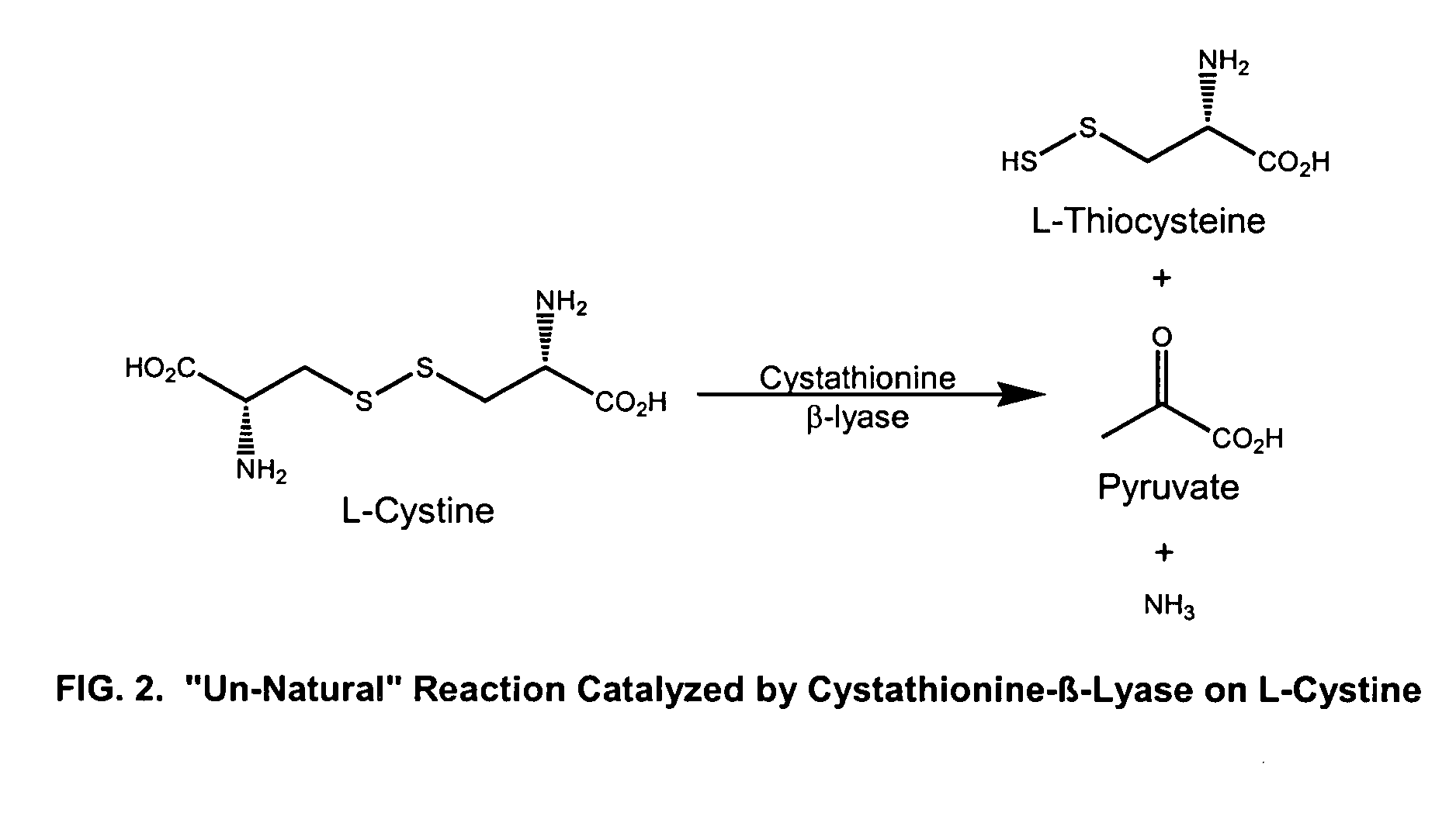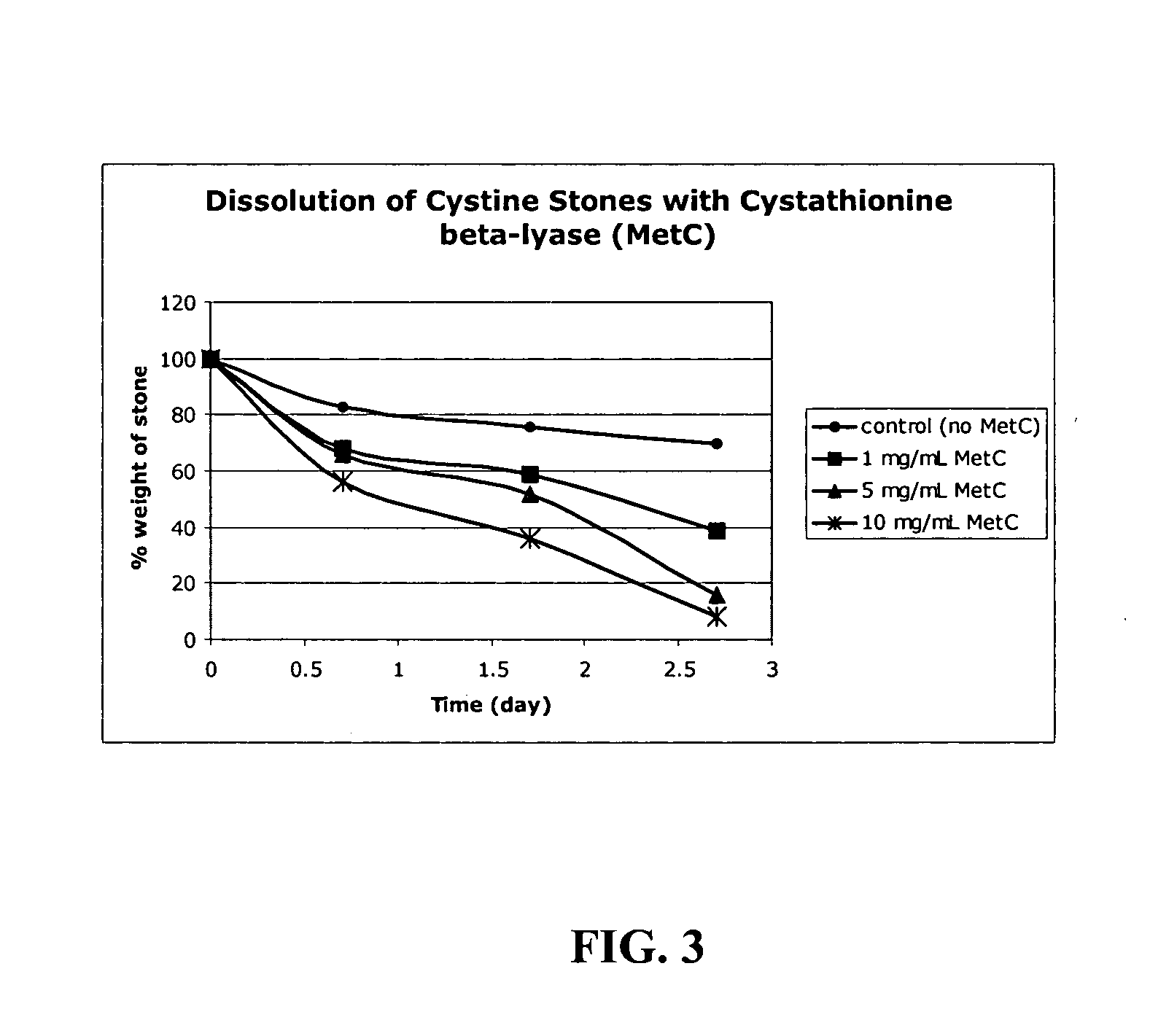Methods for dissolving cystine stones and reducing cystine in urine
a technology of cystine stones and urine, which is applied in the direction of enzymology, peptide/protein ingredients, lyases, etc., can solve the problems of cystine not being reabsorbed normally, cystinurics often experience a life of misery, and the amino acid transporter assembly is defectiv
- Summary
- Abstract
- Description
- Claims
- Application Information
AI Technical Summary
Benefits of technology
Problems solved by technology
Method used
Image
Examples
example 1
Characterization of Cystathionine-β-Lyase as a Cystinase Enzyme
[0058] The enzyme cystathionine β-lyase, has been isolated from E. coli bacteria and catalyzes degradation of L-cystathionine to L-homocysteine in the biosynthesis of L-methionine. (FIG. 1). This same enzyme has also been reported to catalyze the conversion of L-cystine into pyruvate and thiocysteine as shown in FIG. 2 (Uren, 1987).
[0059] Cystathionine β-lyase was isolated in crude form from E. coli using standard methods. We showed that this enzyme functions as a very effective cystinase, catalyzing the conversion of L-cystine to pyruvate and thiocysteine rapidly and in high yield. We have further tested cystathionine β-lyase against other amino acids and showed that it is highly selective for L-cystine; none of the 19 other naturally-occurring amino acids react, nor does glutathione. The enzyme is not significantly inhibited by pyruvate or other 2-ketoacids that might be present in urine. In addition to L-cystine, on...
example 2
Cloning and Expression of Cystathionine β-Lyase
[0061] Cystathionine β-lyase, encoded by the metC gene, was cloned from E. coli ATCC 37384 using PCR methods based on the known sequence of the gene. Based on the published DNA sequence for the gene from E. coli, two primers were synthesized, incorporating an extra BamHI site at the 5′ ends. The BamHI sites and the start codon are underlined for clarity:
Primer 1:5′-TAC TCA GGA TCC ATG GCG GAC AAA AAG CTT GAT ACTCAA CTG G-3′Primer 2:5′-GCG TGA GGA TCC TTA TAC AAT TCG CGC AAA ACCGGC-3′
[0062] After BamHI treatment, the amplification product was isolated and subcloned into a linearized BamHI expression vector, and the resulting plasmid was transformed into an E. coli host strain for expression.
example 3
Expression of metC in a Microbial Host Strain to Produce Cystathionine β-Lyase
[0063] The cystathionine β-lyase gene was isolated from and expressed in E. coli grown in 400 mL TB media containing 100 mg / μL ampicillin at 30° C. and induced with 0.1 mM isopropyl-β-D-thiogalactopyranoside (IPTG). Cells were harvested and mechanically lysed and the enzyme purified with an ammonium sulfate fractionation, as described below.
[0064] Cystathionine β-lyase, encoded by the metC gene, was cloned from E. coli ATCC 37384 using PCR methods based on the published DNA sequence of the gene (Uren, 1987), as in Example 2. We expressed this gene in pET15b / E. coli BL21(DE3) cells. The recombinant E. coli was cultivated in a 15 liter fermentor, following inoculation from shake flasks grown overnight containing 1.2 L of a chemically defined media containing 0.5% glucose and 0.1 mg / mL ampicillin. The glucose limited fed-batch fermentation was carried out with oxygen control at approximately 32° C. Once the...
PUM
| Property | Measurement | Unit |
|---|---|---|
| pH | aaaaa | aaaaa |
| pH | aaaaa | aaaaa |
| temperature | aaaaa | aaaaa |
Abstract
Description
Claims
Application Information
 Login to View More
Login to View More - R&D
- Intellectual Property
- Life Sciences
- Materials
- Tech Scout
- Unparalleled Data Quality
- Higher Quality Content
- 60% Fewer Hallucinations
Browse by: Latest US Patents, China's latest patents, Technical Efficacy Thesaurus, Application Domain, Technology Topic, Popular Technical Reports.
© 2025 PatSnap. All rights reserved.Legal|Privacy policy|Modern Slavery Act Transparency Statement|Sitemap|About US| Contact US: help@patsnap.com



